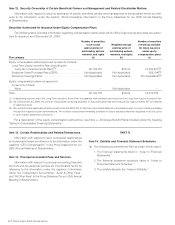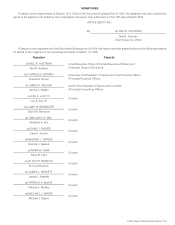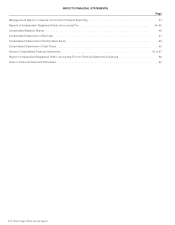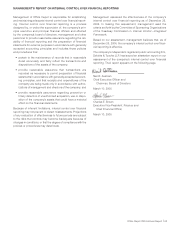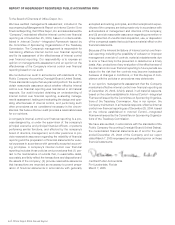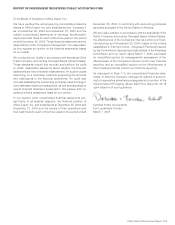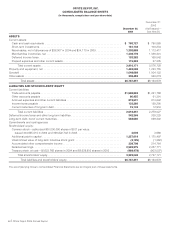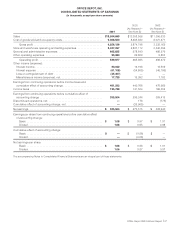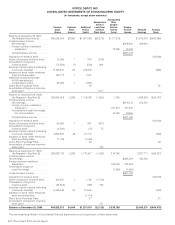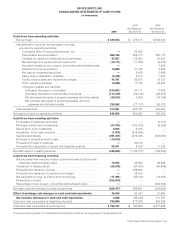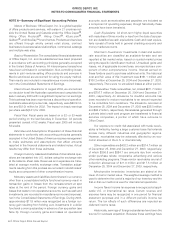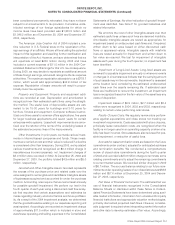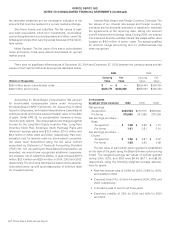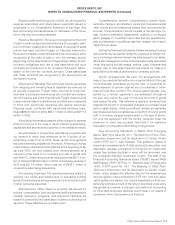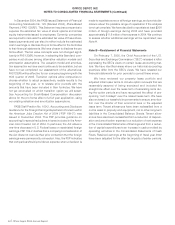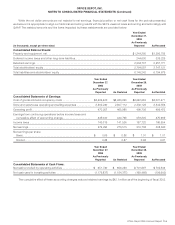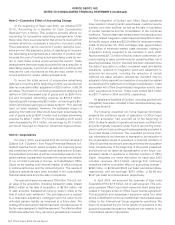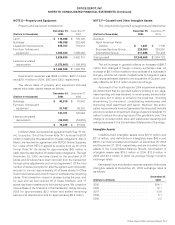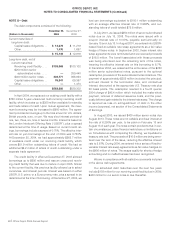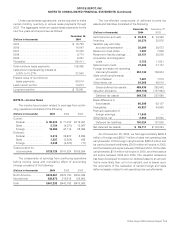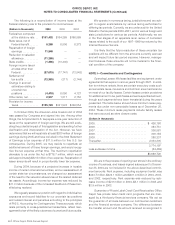Office Depot 2004 Annual Report Download - page 52
Download and view the complete annual report
Please find page 52 of the 2004 Office Depot annual report below. You can navigate through the pages in the report by either clicking on the pages listed below, or by using the keyword search tool below to find specific information within the annual report.OFFICE DEPOT, INC.
NOTES TO CONSOLIDATED FINANCIAL STATEMENTS
50 |Office Depot 2004 Annual Report
accounts, such as receivables and payables, are included as
a component of operating expenses, though historically these
amounts have been immaterial.
Cash Equivalents: All short-term highly liquid securities
with maturities of three months or less from the date of acquisi-
tion are classified as cash equivalents. Cash and cash equiva-
lents consist of funds held in general checking accounts and
money market accounts.
Short-term Investments: Investments in debt and auction
rate securities are classified as available-for-sale and are
reported at fair market value, based on quoted market prices
using the specific identification method. Unrealized gains and
losses, net of applicable income taxes, are reported as a com-
ponent of other comprehensive income. Interest earned on
these funds is used to purchase additional units. The historical
cost and fair value of this investment was $161.1 million and
$100.2 million at December 25, 2004 and December 27, 2003,
respectively. There were no unrealized losses at either period.
Receivables: Trade receivables, net, totaled $871.7 million
and $797.7 million at December 25, 2004 and December 27,
2003, respectively. An allowance for doubtful accounts has
been recorded to reduce receivables to an amount expected
to be collectible from customers. The allowance recorded at
December 25, 2004 and December 27, 2003 was $38.0 million
and $34.2 million, respectively. Receivables generated through
a private label credit card program are transferred to financial
services companies, a portion of which have recourse to
Office Depot.
Our exposure to credit risk associated with trade receiv-
ables is limited by having a large customer base that extends
across many different industries and geographic regions.
However, receivables may be adversely affected by an eco-
nomic slowdown in the U.S. or internationally.
Other receivables are $432.2 million and $314.7 million as
of December 25, 2004 and December 27, 2003, respectively,
of which $356.8 and $284.7 are amounts due from vendors
under purchase rebate, cooperative advertising and various
other marketing programs. These vendor receivables are net of
collection allowances of $11.0 million and $17.5 million at
December 25, 2004 and December 27, 2003, respectively.
Merchandise Inventories: Inventories are stated at the
lower of cost or market value. The weighted average method is
used to determine the cost of a majority of our inventory and the
first-in-first-out method is used for international operations.
Income Taxes: Income tax expense is recognized at appli-
cable U.S. or international tax rates. Certain revenue and
expense items may be recognized in one period for financial
statement purposes and in a different period’s income tax
return. The tax effects of such differences are reported as
deferred income taxes.
Historically, earnings of foreign subsidiaries have been the
source for overseas expansion. Because these earnings have
NOTE A—Summary of Significant Accounting Policies
Nature of Business: Office Depot, Inc. is a global supplier
of office products and services, with sales in 21 countries out-
side the United States and Canada under the Office Depot®,
Viking Office Products®, Viking Direct®, 4Sure.com®,
Guilbert®, and NiceDay™ brand names. Products and services
are offered through wholly owned retail stores, contract
business-to-business sales relationships, commercial catalogs
and multiple web sites.
Basis of Presentation: The consolidated financial statements
of Office Depot, Inc. and its subsidiaries have been prepared
in accordance with accounting principles generally accepted
in the United States of America. All intercompany transactions
have been eliminated in consolidation. Non-controlling invest-
ments in joint ventures selling office products and services in
Mexico and Israel are accounted for using the equity method.
Their results are included in miscellaneous income (expense),
net in the Consolidated Statements of Earnings.
Discontinued Operations: In August 2002, we announced
our decision to sell the Australian operations and completed the
sale in January 2003 with no significant impact on net earnings.
This business has been reported as a discontinued operation.
Australia’s sales and pre-tax loss, respectively, were $80.9 mil-
lion and $(1.0) million for 2002. The impact on basic earnings
per share was $(0.01) for 2002.
Fiscal Year: Fiscal years are based on a 52- or 53-week
period ending on the last Saturday in December. All periods
presented consist of 52 weeks. Fiscal year 2005 will include
53 weeks.
Estimates and Assumptions: Preparation of these financial
statements in conformity with accounting principles generally
accepted in the United States of America requires management
to make estimates and assumptions that affect amounts
reported in the financial statements and related notes. Actual
results may differ from those estimates.
Foreign Currency: Assets and liabilities of international oper-
ations are translated into U.S. dollars using the exchange rate
at the balance sheet date. Revenues and expenses are trans-
lated at average monthly exchange rates. Translation adjust-
ments resulting from this process are recorded in stockholders’
equity as a component of other comprehensive income.
Monetary assets and liabilities denominated in a currency
other than a consolidated entity’s functional currency result in
transaction gains or losses from the remeasurement at spot
rates at the end of the period. Foreign currency gains and
losses that relate to non-operational accounts, such as cash and
investments, are recorded in miscellaneous income (expense),
net in the Consolidated Statements of Earnings. During 2003,
approximately $11.8 million was recognized as a foreign cur-
rency gain resulting from holding euro investments in a dollar
functional currency subsidiary in advance of an acquisition (see
Note D). Foreign currency gains and losses on operational


